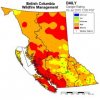http://www.cbc.ca/news/canada/british-columbia/b-c-burning-through-wildfire-budget-1.3122653
B.C. burning through wildfire budget
B.C. Wildfire Management Branch has already spent $52.5 million of its $63 million budget for this year
CBC News Posted: Jun 22, 2015 8:17 AM PT| Last Updated: Jun 22, 2015 8:37 AM PT
Firefighter Jake Sparks pauses for a moment at the Smith Creek fire near West Kelowna, B.C., in July 2014, one of the worst fire seasons on record for the province. (Jonathan Hayward/The Canadian Press)
Related Stories
■Little Bobtail Lake fire 100% contained http://www.cbc.ca/news/canada/british-columbia/little-bobtail-lake-fire-100-contained-1.3086239
■Brush fire at Grouse Mountain highlights wildfire risk http://www.cbc.ca/news/canada/briti...e-mountain-highlights-wildfire-risk-1.3103228
Lightning strikes during hot dry conditions this spring have sparked enough fires to burn through more than 80 per cent of the cash set aside to fight wildfires in B.C. this year.
The B.C. Wildfire Management Branch has already spent $52.5 million of its $63 million budget for this year, said fire information officer Ryan Turcot.
In total firefighters have responded to nearly 500 fires already this year, about half of which were lightning-caused and half of which were human-caused, he said.
"The total number of fires responded to this year is a little bit above average, but the increase we're seeing is entirely due to an abnormally high amount of lightning caused fires."
Over 60,000 hectares have burned to date, well above the 10-year average of 16,327 hectares, he said.
"But it is worth noting that over 43,000 of this year's hectares burned are just due to two fires: Little Bobtail Lake fire, as well as the Dunedin fire up in the far north."
■More updates on wildfires in B.C. http://www.cbc.ca/news/canada/british-columbia/topic/Tag/B.C. wildfires
■Knox Mountain fire: evacuation alert lifted in Kelowna http://www.cbc.ca/news/canada/briti...-evacuation-alert-lifted-in-kelowna-1.3122492
■Elaho Valley wildfire likely to grow http://www.cbc.ca/news/canada/briti...with-hot-dry-conditions-in-forecast-1.3122171
■Wildfire burning west of Nanaimo http://www.cbc.ca/news/canada/british-columbia/wildfire-burning-west-of-nanaimo-1.3121845
In previous years when wildfires have required more than the budgeted amount, the provincial government has drawn cash from its contingency fund to cover the extra expenses.
That is what happened in 2014, the third worst season on record, when 1,424 fires consumed more than 359,000 hectares, costing the government $293 million in firefighting efforts.
The worst two B.C. fire seasons recorded were 1958 when fires burned 859,000 hectares and 1961 when 483,000 hectares of land was burned.
Little Bobtail Lake Fire
The Little Bobtail Lake fire burned through 25,569 hectares of land before it was contained earlier this year. (B.C. Wildfire Management Branch)
B.C. burning through wildfire budget
B.C. Wildfire Management Branch has already spent $52.5 million of its $63 million budget for this year
CBC News Posted: Jun 22, 2015 8:17 AM PT| Last Updated: Jun 22, 2015 8:37 AM PT
Firefighter Jake Sparks pauses for a moment at the Smith Creek fire near West Kelowna, B.C., in July 2014, one of the worst fire seasons on record for the province. (Jonathan Hayward/The Canadian Press)
Related Stories
■Little Bobtail Lake fire 100% contained http://www.cbc.ca/news/canada/british-columbia/little-bobtail-lake-fire-100-contained-1.3086239
■Brush fire at Grouse Mountain highlights wildfire risk http://www.cbc.ca/news/canada/briti...e-mountain-highlights-wildfire-risk-1.3103228
Lightning strikes during hot dry conditions this spring have sparked enough fires to burn through more than 80 per cent of the cash set aside to fight wildfires in B.C. this year.
The B.C. Wildfire Management Branch has already spent $52.5 million of its $63 million budget for this year, said fire information officer Ryan Turcot.
In total firefighters have responded to nearly 500 fires already this year, about half of which were lightning-caused and half of which were human-caused, he said.
"The total number of fires responded to this year is a little bit above average, but the increase we're seeing is entirely due to an abnormally high amount of lightning caused fires."
Over 60,000 hectares have burned to date, well above the 10-year average of 16,327 hectares, he said.
"But it is worth noting that over 43,000 of this year's hectares burned are just due to two fires: Little Bobtail Lake fire, as well as the Dunedin fire up in the far north."
■More updates on wildfires in B.C. http://www.cbc.ca/news/canada/british-columbia/topic/Tag/B.C. wildfires
■Knox Mountain fire: evacuation alert lifted in Kelowna http://www.cbc.ca/news/canada/briti...-evacuation-alert-lifted-in-kelowna-1.3122492
■Elaho Valley wildfire likely to grow http://www.cbc.ca/news/canada/briti...with-hot-dry-conditions-in-forecast-1.3122171
■Wildfire burning west of Nanaimo http://www.cbc.ca/news/canada/british-columbia/wildfire-burning-west-of-nanaimo-1.3121845
In previous years when wildfires have required more than the budgeted amount, the provincial government has drawn cash from its contingency fund to cover the extra expenses.
That is what happened in 2014, the third worst season on record, when 1,424 fires consumed more than 359,000 hectares, costing the government $293 million in firefighting efforts.
The worst two B.C. fire seasons recorded were 1958 when fires burned 859,000 hectares and 1961 when 483,000 hectares of land was burned.
Little Bobtail Lake Fire
The Little Bobtail Lake fire burned through 25,569 hectares of land before it was contained earlier this year. (B.C. Wildfire Management Branch)







